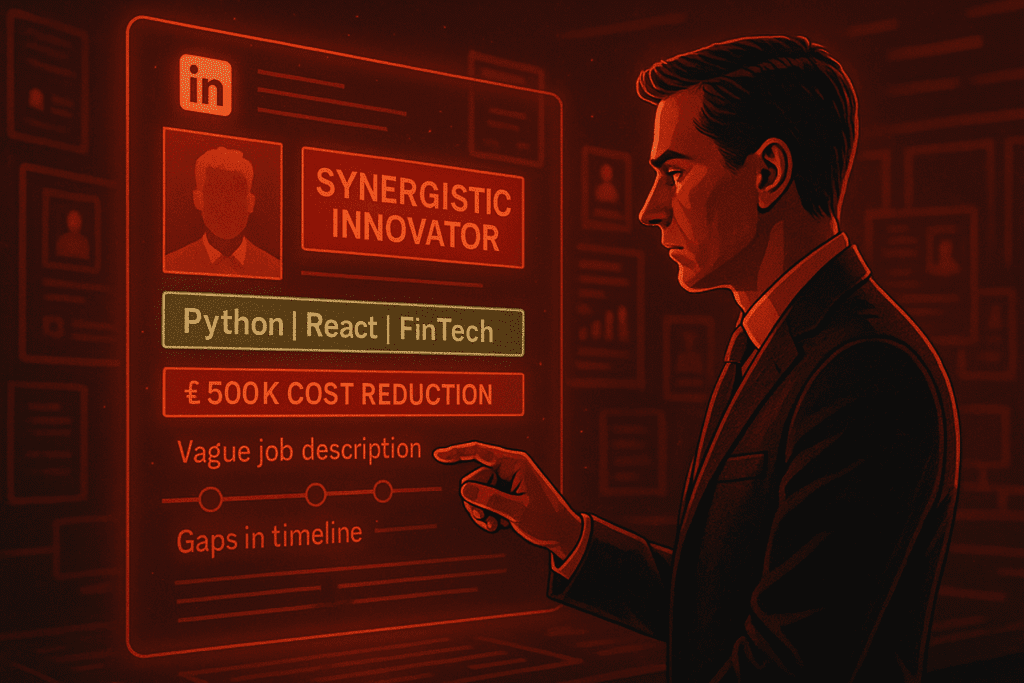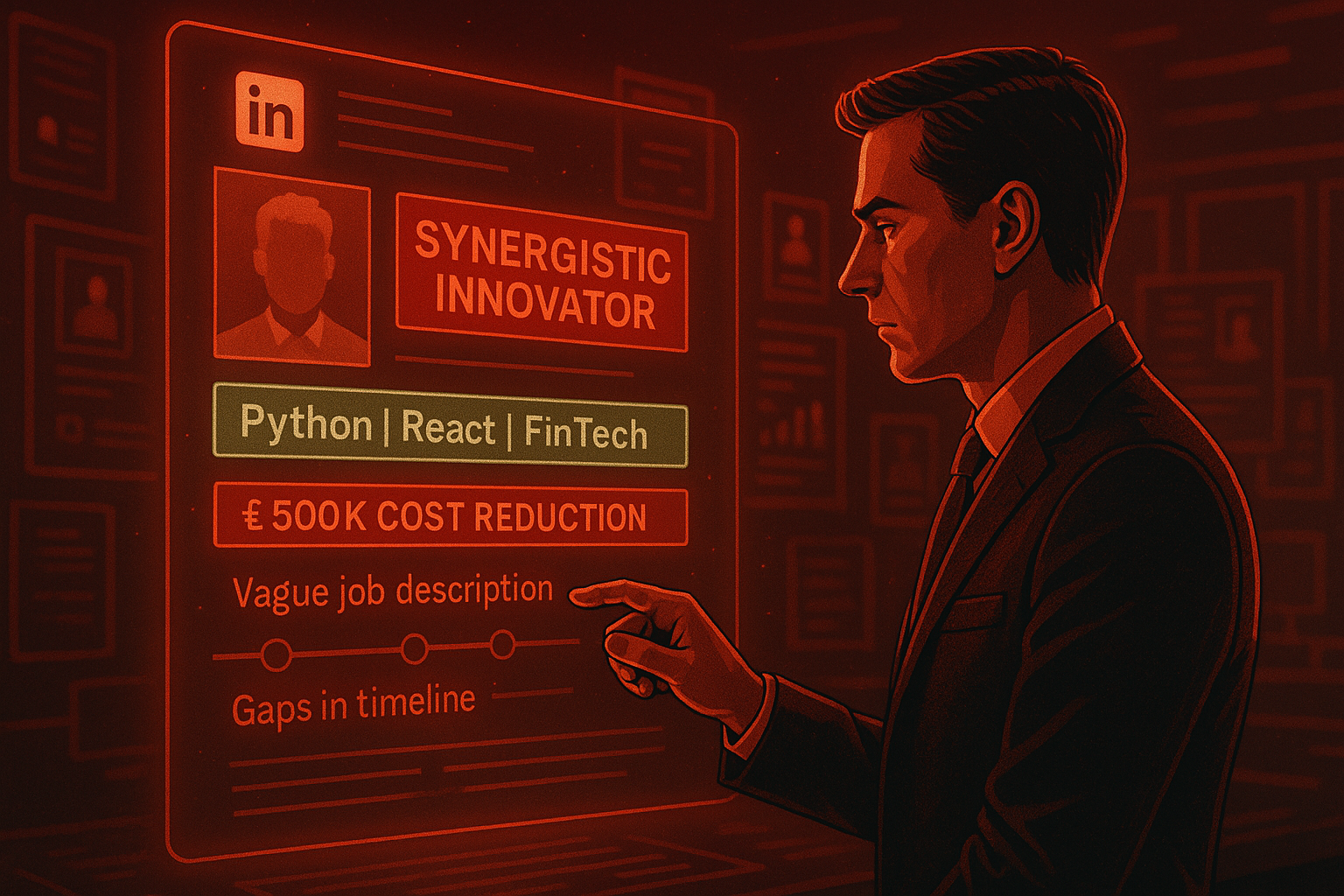What Recruiters Really Think When They See Your LinkedIn

Ever wonder what goes through a recruiter’s mind when they land on your LinkedIn profile? Spoiler alert: it’s not all sunshine and positive thinking. We’re making snap judgements faster than you can say “digital transformation specialist,” and most of those judgements happen in the first five seconds. Brutal? Absolutely. Fair? Debatable. Reality? 100%.
I’ve spent years looking at thousands of profiles, from senior cloud architects to junior developers, and I can tell you exactly what makes me pause with interest versus what makes me click that back button faster than a pop-up on a dodgy website. Here’s your unfiltered insider guide to what recruiters actually think when we’re stalking – sorry, researching – your LinkedIn profile.
The First 5 Seconds – What Jumps Out
Let’s start with the uncomfortable truth: we’re judging your book by its cover, and the cover is your profile picture, headline, and location. That’s it. Five seconds to make a first impression.
Your profile picture? We’re not looking for perfection, but for crying out loud, use a proper photo. That pixelated group shot where we have to guess which one is you? Nope. The motivational quote over a sunset? Double nope. The professional-looking headshot from 2010 where you look suspiciously younger? We can tell. Just get a decent photo taken. It doesn’t need to cost a fortune – a simple, clear photo where you look vaguely like the person who’ll show up to the interview will do.
Your headline is prime real estate, yet most people waste it. “Experienced Professional in the Tech Industry” tells me absolutely nothing. What tech? Experienced in what? “Full Stack Developer | Python, React, AWS | Building Solutions for FinTech” – now we’re talking. Be specific. Be confident. And please, for the love of all that is holy, don’t just copy-paste your job title.
Location matters more than you think. If you’re in Manchester but looking for remote roles, say so. If you’re in London but willing to relocate, mention it. We’re practical creatures – we need to know if this is a logistical nightmare or a perfect match.
Are You Credible? Or Confusing?
After those crucial five seconds, we’re scanning for credibility. And nothing screams “amateur hour” like a profile that can’t keep its story straight.
Job titles should make sense in sequence. If you were a “Senior Data Scientist” at company A and then a “Junior Analyst” at company B, we’re going to have questions. Not saying it can’t happen, but you better address it somewhere. Consistency isn’t just about progression – it’s about showing you understand your own career path.
Formatting matters. Inconsistent date formats, random capitalization, bullet points that suddenly become paragraphs halfway through your experience section – it’s all telling us you don’t sweat the details. And in tech, details matter. A lot.
Here’s a pet peeve: vague job descriptions. “Responsible for various projects in the technology sector.” Come on. What projects? What technology? What were the results? If you can’t articulate what you did in your last role clearly, how can we trust you to explain complex technical concepts to our clients?
The Silent Deal Breakers
Some things will get your profile closed faster than a browser with too many tabs. Let’s start with the obvious: complete radio silence. If your last activity was wishing someone happy birthday in 2019, we’re going to assume you’re either dead or completely checked out of your career. You don’t need to be a LinkedIn influencer, but show some signs of professional life.
Buzzword stuffing is another instant turn-off. “Synergistic innovator with disruptive ideation capabilities and blockchain-enhanced mindset paradigms”? Just… no. Use real words. Describe real achievements. We’re not impressed by your thesaurus skills; we’re impressed by results.
Missing dates are suspicious. Gap in employment? Address it briefly. Overlapping roles? Explain it. Dates that don’t add up? Fix them. We’re not judging career gaps (well, most of us aren’t), but we are judging people who try to hide them.
And let’s talk about recommendations. Having none is fine. Having one from your mum’s friend who hired you to fix her laptop? Not fine. Quality over quantity always.
How to Win Attention (and InMail Replies)
Now for the good stuff – how to actually stand out in a sea of profiles. First rule: personal branding isn’t about being perfect; it’s about being memorable for the right reasons.
Your summary section should read like you’re introducing yourself at a networking event, not writing a doctoral thesis. “I help FinTech companies reduce processing costs through automated cloud solutions. Last year, I saved my employer £500K by redesigning their payment infrastructure. Currently exploring opportunities in AI-powered fraud detection.” See? Personal, specific, achievement-focused. And it took two seconds to read.
Content strategy matters. Share insights, not just job postings. Comment thoughtfully on industry discussions. Post about that interesting problem you solved or that conference you attended. But here’s the key: be genuine. We can spot LinkedIn theatre from a mile away. That polished motivational post about “grateful for this journey” with a stock photo? Yeah, that’s not helping.
Skills and endorsements need strategic thinking. Those 50+ skills that include both “Python” and “Excellent communication”? Trim it down. Focus on the skills that matter for where you want to go, not where you’ve been. Quality endorsements from people we recognize in the industry carry more weight than quantity endorsements from random connections.
Keep your profile current. Not just employment history, but achievements, projects, and even the little things like profile views and article likes. An active profile signals an engaged professional.
Final Thoughts
Here’s the reality: recruiters spend an average of six seconds on initial profile reviews. Six. That means everything I’ve outlined above needs to be immediately obvious and professionally polished. Harsh? Maybe. But in a world where we’re sifting through hundreds of profiles for a single role, first impressions aren’t just important – they’re everything.
The good news? Standing out doesn’t require major life changes or expensive profile makeovers. It requires attention to detail, honest self-presentation, and a bit of strategic thinking about how you want to be perceived.
Remember, LinkedIn isn’t just your online CV; it’s your digital first impression. Make it count. Because while we might only spend six seconds on that initial glance, the right profile can turn those six seconds into a career-changing conversation.
Want a recruiter’s honest take on your LinkedIn profile? At Oliver Parks, we help you present your best professional self. Get real feedback from people who look at hundreds of profiles every week.
[Request your profile audit →]
Trust me, it’s better to know where you stand than to wonder why your InMail response rate is basically zero. Let’s fix that together.




